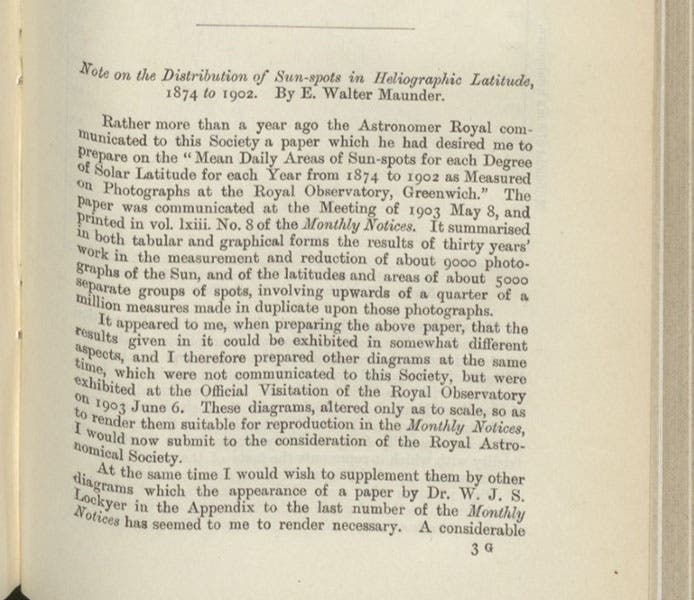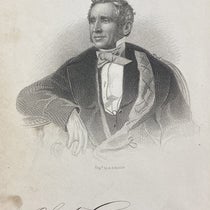Scientist of the Day - E. Walter Maunder
Edward Walter Maunder, an English astronomer, was born Apr. 12, 1851. Maunder was a student of sunspots, especially as they had appeared historically, and in an important paper of 1904, he revealed that, at the beginning of the 11-year sunspot cycle, sunspots are at a high latitude on the sun in both the northern and southern hemispheres; by the end, sunspots are clustered around the solar equator, and before these finally disappear, a new set returns at high latitudes. If you plot the sunspot positions and their latitudes over time, you get a lovely diagram, aptly called the butterfly diagram. We see above the original version as published with Maunder’s paper in the Monthly Notices of the Royal Astronomical Society in 1904. The butterfly diagram is a powerful example of the value of graphics in science, since the butterfly pattern is not at all apparent from the data – it shows itself only when you plot it. Since it is even more striking in color, we show below (fourth image) a modern butterfly diagram, covering 11 sunspot cycles, and looking like Monarchs fluttering in from Mexico in single file.
A little earlier in his research (in 1890), Maunder discovered that during the years from 1645 to 1715, there were very few sunspots seen, even though lots of people were looking for them (Galileo and several others first discovered sunspots in 1611). Actually, Maunder's “discovery” consisted of introducing into English the work of the German astronomer Gustav Spörer, who published two papers on the subject in 1887 and 1889. Maunder's papers appeared in 1890 and 1894. His 1890 paper was titled, "Professor Spoerer's researches on sun-spots", so he was not trying to take credit for the discovery. Maunder's second paper was called: “A prolonged sunspot minimum." As it happened, the period of low sunspot activity coincided (more or less), with an era of lower-than-normal temperatures, called the "Little Ice Age." It seemed possible that the two were connected. Historian of astronomy John Eddy thought that they were, and he published an article in 1976 in Science called "The Maunder Minimum” (fifth image, below). The period of low sunspot activity, 1645-1715, has been the Maunder Minimum ever since. The case for calling it the Spörer Minimum is a good one, but it has no chance, I fear, of ever making it into court.
Assuming there is a connection between sunspot activity and the Earth’s climate, two scientists proposed in 2003 that Stradivarius violins owe their tonal excellence to close-grained wood that grew more slowly in those years, because of the colder, Maunder-Minimum induced climate. I looked to see if the proposal had been refuted in the 20 years since, but could not find any further study, pro or con. When Nina Totenberg's father's Strad was recovered in 2015, after being stolen 35 years before, the Strad-Maunder-Minimum connection was repeated in the press, so it is living on, rightly or wrongly.
Walter's wife, Annie Russell Maunder, was an accomplished astronomer herself, although she lived in an era when he could not pursue astronomy professionally. She is known to have worked closely with her husband on the study of sunspots, and she is often credited with discovering the butterfly pattern. If there is any evidence for this assertion, I have not seen it. But there is good evidence for their collaboration; they went on many eclipse expeditions together, and together they wrote a book, The Heavens and Their Story, published in 1908, with Annie listed as first author. This is a beautiful, lavishly illustrated volume, of which you will soon get a glimpse. Since Annie's birthday came just two days after Walter's, we will feature Annie and the book just two days from now.
Dr. William B. Ashworth, Jr., Consultant for the History of Science, Linda Hall Library and Associate Professor emeritus, Department of History, University of Missouri-Kansas City. Comments or corrections are welcome; please direct to ashworthw@umkc.edu.











